Ship transport


Ship transport is primarily used for the carriage of people and non-perishable goods, generally referred to as cargo.
Although the historic importance of sea travel for passengers has decreased, due to the rise of commercial aviation, it is still very effective for short trips and pleasure cruises. Sea transport remains the largest carrier of freight in the world.
While slower than air transport, modern sea transport is a highly effective method of moving large quantities of non-perishable goods. Transport by water is significantly less costly than transport by air for trans-continental shipping.
Ship transport is often international by nature, but it can be accomplished by barge, boat, ship or sailboat over a sea, ocean, lake, canal or river. This is frequently undertaken for purposes of commerce, recreation or military objectives. When a cargo is carried by more than one mode, the transport is termed intermodal or co-modal.
Ships have long been used for warfare, with applications from naval supremacy to piracy, invasions and bombardment. Aircraft carriers can be used as bases of a wide variety of military operations.
Ship transport is used for a variety of unpackaged raw materials ranging from chemicals, petroleum products, and bulk cargo such as coal, iron ore, cereals, bauxite, and so forth. So called "general cargo" covers goods that are packaged to some extent in boxes, cases, pallets, barrels, and so forth. Since the 1960s containerization has revolutionized ship transport.
Contents[hide] |
Merchant shipping
A nation's merchant fleet comprises the ships that are used to transport cargo during times of peace and war. A country's merchant marine or Merchant Navy is the combination of the fleet with the people who man it. There are a number of terms applied to the people who operate the ships, from merchant sailor to merchant mariner, to simply sailor or mariner.
According to the 2005 CIA World Factbook, the world total number of merchant ships of 1,000 Gross Register Tons or over was 30,936. Statistics for individual countries are available at the List of merchant marine capacity by country.
Professional mariners
-
For more details on this topic, see Seafarer's professions and ranks.
Seafarers hold a variety of professions and ranks, each of which carry unique responsibilities which are integral to the successful operation of a seafaring vessel. A ship's complement can generally be divided into four main categories: the deck department, the engineering department, the steward's department, and other.
Deck department
-
For more details on this topic, see Deck department.

Officer positions in the deck department include but not limited to: Master and his Chief, Second, and Third officers. The official classifications for unlicensed members of the deck department are Able Seaman and Ordinary Seaman.
A common deck crew for a ship includes:
- (1) Chief Officer/Chief Mate
- (1) Second Officer /Second Mate
- (1) Third Officer / Third Mate
- (1) Boatswain
- (2-6) Able Seamen
- (0-2) Ordinary Seamen
A deck cadet is person who is carrying out mandatory seatime to achieve his/her officer of the watch certificate. Their time onboard is spent learning the operations and tasks of everyday life on a merchant vessel.
Engineering department
-
For more details on this topic, see Engineering department.
A ship's engineering department consists of the members of a ship's crew that operate and maintain the propulsion and other systems on board the vessel. Marine Engineering staff also deal with the "Hotel" facilities on board, notably the sewage, lighting, air conditioning and water systems. They deal with bulk fuel transfers, and require training in firefighting and first aid, as well as in dealing with the ship's boats and other nautical tasks- especially with cargo loading/discharging gear and safety systems, though the specific cargo discharge function remains the responsibility of deck officers and deck workers. On LPG and LNG tankers however, a cargo engineer works with the deck department during cargo operations, as well as being a watchkeeping engineer.
A common Engineering crew for a ship includes:
- (1) Chief Engineer
- (1) Second Engineer / First Assistant Engineer
- (1) Third Engineer / Second Assistant Engineer
- (1-2) Fourth Engineer / Third Assistant Engineer
- (0-2) Fifth Engineer / Junior Engineer
- (1-3) Oiler (unlicensed qualified rating)
- (0-3) Greaser/s (unlicensed qualified rating)
- (1-5) Entry-level rating (such as Wiper (occupation), Utilityman, etc)
Many American ships also carry a Qualified Member of the Engine Department. Other possible positions include Motorman, Machinist, Electrician, Refrigeration Engineer, and Tankerman. Engine Cadets are trainee engineers who are completing sea time necessary before they can obtain a watchkeeping license.
Steward's department
-
For more details on this topic, see Steward's department.
A typical Steward's department for a cargo ship would be composed of a Chief Steward, a Chief Cook, and a Steward's Assistant. All three positions are typically filled by unlicensed personnel.
The chief steward directs, instructs, and assigns personnel performing such functions as preparing and serving meals; cleaning and maintaining officers' quarters and steward department areas; and receiving, issuing, and inventorying stores.
On large passenger vessels, the Catering Department is headed by the Chief Purser and managed by assistant pursers. Although they enjoy the benefits of having officer rank, they generally progress through the ranks to become pursers. Under the pursers are the department heads - such as chief cook, head waiter, head barman etc. They are responsible for the administration of their own areas.
The chief steward also plans menus; compiles supply, overtime, and cost control records. May requisition or purchase stores and equipment. May bake bread, rolls, cakes, pies, and pastries.
A chief steward's duties may overlap with those of the Steward's Assistant, the Chief Cook, and other Steward's Department crewmembers.
In the United States Merchant Marine, in order to be occupied as a chief steward a person has to have a Merchant Mariner's Document issued by the United States Coast Guard. Because of international conventions and agreements, all chief cooks who sail internationally are similarly documented by their respective countries.
Other Departments
-
For more details on this topic, see Seafarer's professions and ranks#Other.
Various types of staff officer positions may exist on board a ship, including Junior Assistant Purser, Senior Assistant Purser, Purser, Chief Purser, Medical Doctor, Professional Nurse, Marine Physician Assistant, and Hospital Corpsman, are considered administrative positions and are therefore regulated by Certificates of Registry issued by the United States Coast Guard. Pilots are also merchant marine officers and are licensed by the Coast Guard. Formerly, there was also a radio department, headed by a chief radio officer and supported by a number of radio officers. Since the introduction of GMDSS (Satellite communications) and the subsequent exemptions from carrying radio officers if the vessel is so equipped, this department has fallen away, although many ships do still carry specialist radio officers, particularly passenger vessels. Many radio officers became 'electro-technical officers', and transferred into the engineering department.
Life at sea

Mariners live on the margins of society, with much of their life spent beyond the reach of land. They face cramped, stark, noisy, and sometimes dangerous conditions at sea. Yet men and women still go to sea. For some, the attraction is a life unencumbered with the restraints of life ashore. Sea-going adventure and a chance to see the world also appeal to many seafarers. Whatever the calling, those who live and work at sea invariably confront social isolation.
Findings by the Seafarer's International Research Center indicate a leading cause of mariners leaving the industry is "almost invariably because they want to be with their families." U.S. merchant ships typically do not allow family members to accompany seafarers on voyages. Industry experts increasingly recognize isolation, stress, and fatigue as occupational hazards. Advocacy groups such as International Labor Organization, a United Nations agency, and the Nautical Institute are seeking improved international standards for mariners.
Ocean voyages are steeped in routine. Maritime tradition dictates that each day be divided into six four-hour periods. Three groups of watchkeepers from the engine and deck departments work four hours on then have eight hours off watchkeeping. However there are many overtime jobs to be done daily. This cycle repeats endlessly, 24 hours a day while the ship is at sea. Members of the steward department typically are day workers who put in at least eight-hour shifts. Operations at sea, including repairs, safeguarding against piracy, securing cargo, underway replenishment, and other duties provide opportunities for overtime work. One’s service aboard ships typically extends for months at a time, followed by protracted shore leave. However, some seamen secure jobs on ships they like and stay aboard for years.
In rare cases, veteran mariners choose never to go ashore when in port. Further, the often quick turnaround of many modern ships, spending only a matter of hours in port, limits a seafarer's free-time ashore. Moreover, some foreign seamen entering U.S. ports from a watchlist of 25 high-risk countries face restrictions on shore leave due to security concerns in a post 9/11 environment. However, shore leave restrictions while in U.S. ports impact American seamen as well. For example, the International Organization of Masters, Mates & Pilots notes a trend of U.S. shipping terminal operators restricting seamen from traveling from the ship to the terminal gate. Further, in cases where transit is allowed, special "security fees" are at times assessed.
Such restrictions on shore leave coupled with reduced time in port by many ships translate into longer periods at sea. Mariners report that extended periods at sea living and working with shipmates who for the most part are strangers takes getting used to. At the same time, there is an opportunity to meet people from a wide range of ethnic and cultural backgrounds. Recreational opportunities have improved aboard some U.S. ships, which may feature gyms and day rooms for watching movies, swapping sea stories, and other activities. And in some cases, especially tankers, it is made possible for a mariner to be accompanied by members of his family. However, a mariner’s off duty time is largely a solitary affair, pursuing hobbies, reading, writing letters, and sleeping.
On modern ocean going vessels, typically registered with a flag of convenience, life has changed immensely in the last 20 years. Most large vessels include a gym and often a swimming pool for use by the crew. Since the Exxon Valdez Incident, the focus of leisure time activity has shifted from having Officer and Crew bars, to simply having lounge-style areas where officers or crew can sit to watch movies. With many companies now providing TVs and DVD players in cabins, and enforcing strict smoking policies, it is not surprising that the bar is now a much quieter place on most ships. In some instances games consoles are provided for the officers and crew. The officers enjoy a much higher standard of living on board ocean going vessels. Crews are generally poorly paid, poorly qualified and have to complete contracts of approx 9 months before returning home on leave. They often come from countries where the average industrial wage is still very low, such as the Philippines or India. Officers however, come from all over the world and it is not uncommon to mix the nationality of the officers on board ships. Officers are often the recipients of university degrees and have completed vast amounts of training in order to reach their rank. Officers benefit on board by having larger, more comfortable cabins, table service for their meals, etc. Contracts average at the 4 month mark for officers, with generous leave. Most Ocean going vessels now operate an Unmanned Engineroom System allowing engineers to work days only. The engine room is computer controlled by night, although the duty engineer will make inspections during unmanned operation. Engineers work in a hot, humid, noisy atmosphere. Communication in the engineroom is therefore by hand signals and lip-reading, and good teamwork often stands in place of any communication at all.
Many countries have their own merchant fleets.
-
For more details on this topic, see Greek shipping.
According to the BTS and the World Factbook, the Greek maritime fleet is today the largest in the world, with 3,099 vessels of 1000 Tonnes or more (December 13, 2007) accounting for 18% of the world's fleet capacity. About half of the vessels fly the Greek flag and the remainder mainly flags of convenience. Greek vessels consist about half of total EU tonnage and created 7.6% of Greece's GDP in 2007 (about 17 billion euros) [1]. Thus Greece is the largest shipping-nation in the world with a total of 141,931,000 metric tons of deadweight (DWT).[30] In terms of ship categories, Greece ranks first in both tankers and dry bulk carriers, fourth in the number of containers, and fourth in other ships. In the 1970's Greece was even bigger with circa 5000 ships.
-
For more details on this topic, see British Merchant Navy.

The British Merchant Navy or simply Merchant Navy comprises the British merchant ships that transport cargo and people during time of peace and war.
For long periods of the last millennium, the Merchant Navy had the largest merchant fleet in the world, but it has slipped down the rankings. Today, there are 429 ships of 1,000 GRT or over, making a total of 9,181,284 GRT (9,566,275 DWT). These are split into the following types: bulk carrier 18, cargo 55, chemical tanker 48, container 134, liquefied gas 11, passenger 12, passenger/cargo 64, petroleum tanker 40, refrigerated cargo 19, roll on/roll off 25, vehicle carrier 3. There are also 446 ships registered in other countries, and 202 foreign-owned ships registered in the UK. (2005 CIA estimate)
-
For more details on this topic, see Canadian Merchant Navy.
Canada, like several other Commonwealth nations created its own Merchant Navy in a large-scale effort in World War Two. The Canadian Merchant Navy played a major role in the Battle of the Atlantic bolstering the Allies' merchant fleet due to high losses in the British Merchant Navy. Eventually thousands of Canadians served in the Merchant Navy aboard hundreds of Canadian merchant ships, notably the "Park Ships", the Canadian equivalent of the American "Liberty Ship". A school at St. Margarets Bay, Nova Scotia trained Canadian merchant mariners. "Manning Pools", Merchant Navy barracks were built in Canadian ports. Considered a fourth branch of the Canadian military, after the Canadian Army, Royal Canadian Navy, and Royal Canadian Air Force, the Canadian Merchant Navy suffered a higher casualty rate of the four services. After the war, Canadian Merchant Navy veterans were denied veterans benefits and official recognition for decades. This was not changed until the 1990s and many individual cases remain unresolved.
Swiss Merchant Marine
-
For more details on this topic, see Merchant Marine of Switzerland.
Switzerland has a civilian high seas fleet of merchant vessels, whose home port is Basel, in Switzerland. The first ships were purchased and operated by the government in order to ensure the supply of critical resources during World War II. After the war, a privately owned merchant fleet emerged, spurred in part by government subsidies that paid for the fleet's operation up until 1953.
As of 2006, 26 ships (mostly container carriers) totalling 479,624 tons, operated by five shipping companies, fly the Swiss flag.
United States Merchant Marine
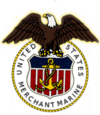
-
For more details on this topic, see United States Merchant Marine.
The United States Merchant Marine is made up of the nation's civilian-owned merchant ships and the men and women that crew them. The merchant marine transports cargo and passengers during peace time. In time of war, the merchant marine[2] is an auxiliary to the Navy, and can be called upon to deliver troops and supplies for the military.
The people of the merchant marine are called merchant mariners, and are civilian except in times of war, when, in accordance with the Merchant Marine Act of 1936 they are considered military personnel.
As of 2006, the United States merchant fleet numbered 465 ships[3] and approximately 69,000 people. Seven hundred ships owned by American interests but registered, or flagged, in other countries are not included in this number.
Ships and watercraft
- Further information: Ship and Merchant ship
Ships and other watercraft are used for ship transport. Various types can be distinguished by propulsion, size or cargo type. Recreational or educational craft still use wind power, while some smaller craft use internal combustion engines to drive one or more propellers, or in the case of jet boats, an inboard water jet. In shallow draft areas, such as the Everglades, some craft, such as the hovercraft, are propelled by large pusher-prop fans.
Most modern merchant ships can be placed in one of a few categories, such as:
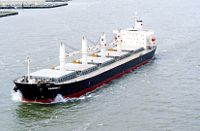 |
Bulk carriers are cargo ships used to transport bulk cargo items such as ore or food staples (rice, grain, etc.) and similar cargo. It can be recognized by the large box-like hatches on its deck, designed to slide outboard for loading. A bulk carrier could be either dry or wet. Most lakes are too small to accommodate bulk ships, but a large fleet of lake freighters has been plying the Great Lakes and St. Lawrence Seaway of North America for over a century. |
 |
Container ships are cargo ships that carry their entire load in truck-size containers, in a technique called containerization. They form a common means of commercial intermodal freight transport. Informally known as "box boats," they carry the majority of the world's dry cargo. Most container ships are propelled by diesel engines, and have crews of between 20 and 40 people. They generally have a large accommodation block at the stern, directly above the engine room. |
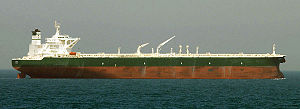 |
Tankers are cargo ships for the transport of fluids, such as crude oil, petroleum products, liquefied petroleum gas, liquefied natural gas and chemicals, also vegetable oils, wine and other food - the tanker sector comprises one third of the world tonnage. |
 |
Reefer ships are cargo ships typically used to transport perishable commodities which require temperature-controlled transportation, mostly fruits, meat, fish, vegetables, dairy products and other foodstuffs. |
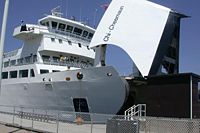 |
Roll-on/roll-off ships are cargo ships designed to carry wheeled cargo such as automobiles, trailers or railway carriages. RORO (or ro/ro) vessels have built-in ramps which allow the cargo to be efficiently "rolled on" and "rolled off" the vessel when in port. While smaller ferries that operate across rivers and other short distances still often have built-in ramps, the term RORO is generally reserved for larger ocean-going vessels. |
 |
Coastal trading vessels, also known as coasters, are shallow-hulled ships used for trade between locations on the same island or continent. Their shallow hulls mean that they can get through reefs where sea-going ships usually cannot (sea-going ships have a very deep hull for supplies and trade etc.). |
 |
Ferries are a form of transport, usually a boat or ship, but also other forms, carrying (or ferrying) passengers and sometimes their vehicles. Ferries are also used to transport freight (in lorries and sometimes unpowered freight containers) and even railroad cars. Most ferries operate on regular, frequent, return services. A foot-passenger ferry with many stops, such as in Venice, is sometimes called a waterbus or water taxi. Ferries form a part of the public transport systems of many waterside cities and islands, allowing direct transit between points at a capital cost much lower than bridges or tunnels. Many of the ferries operating in Northern European waters are ro/ro ships. See the Herald of Free Enterprise and M/S Estonia disasters. |
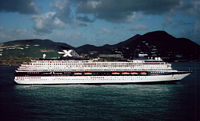 |
Cruise ships are passenger ships used for pleasure voyages, where the voyage itself and the ship's amenities are considered an essential part of the experience. Cruising has become a major part of the tourism industry, with millions of passengers each year as of 2006. The industry's rapid growth has seen nine or more newly built ships catering to a North American clientele added every year since 2001, as well as others servicing European clientele. Smaller markets such as the Asia-Pacific region are generally serviced by older tonnage displaced by new ships introduced into the high growth areas. |
| Cable layer is a deep-sea vessel designed and used to lay underwater cables for telecommunications, electricity, and such. A large superstructure, and one or more spools that feed off the transom distinguish it. | |
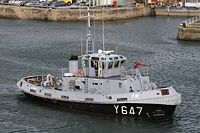 |
A tugboat is a boat used to manoeuvre, primarily by towing or pushing other vessels (see shipping) in harbours, over the open sea or through rivers and canals. They are also used to tow barges, disabled ships, or other equipment like towboats. |
| A dredger (sometimes also called a dredge) is a ship used to excavate in shallow seas or fresh water areas with the purpose of gathering up bottom sediments and disposing of them at a different location. | |
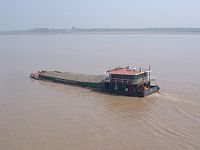 |
A barge is a flat-bottomed boat, built mainly for river and canal transport of heavy goods. Most barges are not self-propelled and need to be moved by tugboats towing or towboats pushing them. Barges on canals (towed by draft animals on an adjacent towpath) contended with the railway in the early industrial revolution but were outcompeted in the carriage of high value items due to the higher speed, falling costs, and route flexibility of rail transport. |
Ships do exist that fall outside these categories, such as Semi-submersible heavy-lift ships.
Typical in-transit times
A cargo ship sailing from a European port to a US one will typically take 10-12 days based on water currents and other factors.
Ship transport infrastructure
- Further information: Port
For a port to efficiently send and receive cargo, it requires some infrastructure. Harbors, seaports and marinas host watercraft, and consist of components such as piers, wharfs, docks and roadsteads.
A port is a facility for receiving ships and transferring cargo to and from them. They are usually situated at the edge of an ocean or sea, river, or lake. Ports often have cargo-handling equipment such as cranes (operated by stevedores) and forklifts for use in loading/unloading of ships, which may be provided by private interests or public bodies. Often, canneries or other processing facilities will be located very close by. Harbour pilots, barges and tugboats are often used to safely maneuver large ships in tight quarters as they approach and leave the docks. Ports which handle international traffic will have customs facilities.
Access to other transport systems, such as rail and truck terminals can contribute to a port's efficiency. Some ports feature canals, allow further movement inland.
The presence of deep water in channels or berths, the provision of protection from the wind, waves and storm surges and access to intermodal transportation such as trains or trucks are critical to a good port. A port must also have navigational aids such as lighthouses, buoys and sea marks.
See also
- The Marine Society
- List of merchant marine capacity by country
- List of maritime colleges
- List of notable mariners
- Lloyd's War Medal for Bravery at Sea
- Merchant ship
- History of ship transport
 |
| This article is part of the Transport series |
| Modes... |
|
Animal-powered |
| See also... |
| Topics | Portal |
Notes
- ↑ "Rank Order - Merchant marine". CIA.gov. Retrieved on 2007-05-21.
- ↑ Most English-speaking countries call their fleet the Merchant Navy. Terms similar to Merchant Marine are used in, for example, the French Marine Marchande and the Spanish Marina Mercante.
- ↑ Ships of 1,000 gross register tons (GRT) tons or over. Fleet statistics from the 2006 CIA World Factbook
References
- Office of Data and Economic Analysis (July 2006). "World Merchant Fleet 2001–2005" (PDF). United States Maritime Administration. Retrieved on March 13, 2007.
- Thompson, Mark L. (1994). Queen of the Lakes. ISBN 0814323936.
- United Nations Council on Trade and Development (UNCTAD) (2005). Review of Maritime Transport, 2005. New York and Geneva: United Nations. http://www.unctad.org/Templates/StartPage.asp?intItemID=2614&lang=1.
- United Nations Council on Trade and Development (UNCTAD) (2006). Review of Maritime Transport, 2006. New York and Geneva: United Nations. http://www.unctad.org/en/docs/rmt2006_en.pdf.
External links
- Mercantile Marine community
- Merchant Navy officer's community
- Water Transportation Marine companies
- Social & Economic Benefits of Marine Transport from "NOAA Socioeconomics" website initiative
- Thomas Cook Timetable - provides a list of all known airplane, rail and boat connections
- AXS-Alphaliner Top 100 - liner market share in TEUs (updated daily)
|
|||
|
||